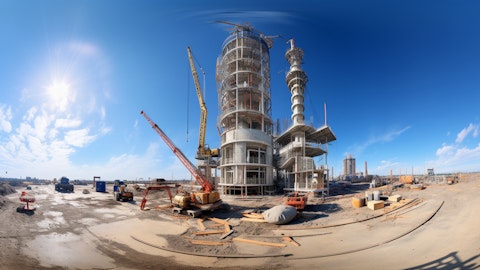Scott Anderson: Yeah, Mike. First of all, we are hopeful in ’24 that we will see that moderation. And we’re actually going through our budgets right now, and we are seeing some cost. Actually barging cost is one that’s actually surprised us to see the increases we’re hearing in the barging side along the Mississippi River. So we’re going to accommodate that in our budget for next year. But overall on the specific assumptions, we’re in that mid-single-digits right now. But as Anne mentioned, we’ll have a finer point on that when we come back to you in February on the broader.
Anne Noonan: Yeah, I think just to give you for a magnitude, Mike, you know, one of the reasons why we’re going out with a very strong price increase in cement with $15 a ton is because our barge costs are up about 9% to 10% even with mitigation by our team. So we’re working hard on that. We continue, as Scott said, to see cost inflation, but we do think it will moderate somewhat next year. But we’re going to continue with a strong pricing stance and control what we can control on our costs, really focus on operational excellence on both ags and cement and really drive our costs down. That’s what we can control in 2024.
Mike Dahl: Got it. Okay. Thanks, Anne. Thanks, Scott.
Anne Noonan: Thanks, Mike.
Operator: All right. Our next question comes from the line of Jerry Revich from Goldman Sachs. Jerry, please go ahead.
Jerry Revich: Yes, hi, good morning everyone.
Anne Noonan: Good morning, Jerry.
Jerry Revich: And I’m wondering — hi. I’m wondering if we just talk about the margin potential of the products business as it stands today and what the opportunity is for margin expansion from here, you know, assuming flattish volumes. Historically, this business at some point has gotten into the high-20s on a cash gross profit margin basis. But obviously, the portfolio has evolved. So just wondering for that part of the portfolio specifically, how do you feel about the opportunity to push price ahead of costs over the medium term?
Anne Noonan: Yeah, so one of the things we do like. So this is our downstream businesses essentially and if you look at both, let’s take them separately. So our ready-mix business, we’ve clearly shown our ability in the past to do 20s, and we’re good at ready-mix. We’re just very good at the downstream. And with the portfolio work that we’ve done, I wouldn’t have said this two years ago with the portfolio work we’ve done, we’re in the right markets with advantaged assets and we’ve leading positions. The other thing our team has done a lot of work on in ready-mix as we very much lead in innovation. The team has done a lot of work around AI, around the ad mixtures. So, the value proposition that they bring and the ability to expand margins in the strong markets is where we see that ability to pop that 20%.
But very importantly all these downstream business have heroic, and that’s why we’re in these markets and that’s a key part. The other point I’d point you to is on our asphalt and construction. They very much upheld by very strong public demand right now. Liquid asphalt has moderated off a little bit. So that price net of cost in asphalt, you can see that pop in the margin. So I’m very confident that our team will at least be able to continue to add points of margin in both of our downstream business because of where we play and because of our focus on our improvement of our operational capability and value proposition to the customer.
Jerry Revich: Super. Thanks.
Anne Noonan: Thanks, Jerry.
Operator: All right. Our next question comes from the line of Keith Hughes from Truist. Keith, please go ahead.
Keith Hughes: Thank you. On the aggregate pricing in the fourth quarter guide, I see historically you’re talking about you have some seasonal decline from third to fourth. But given these numbers, this looks particularly large. Is there something unusual going on this year that you’re going to see more of a seasonal impact than you would have in past years?
Anne Noonan: No, I mean I’ll let Scott go to specifics, if you want, but honestly, it’s not any different. We always see this seasonality in Q4 around pricing, so it can get a little bumpy around that. But our pricing is still very strong. You know, if you think about our aggregates pricing from the mid — you know, the mid-year price increases, you know, at the top end of that, our carryover ags pricing will be in that mid-single digits, but there was very strong execution. So I wouldn’t read anything into that Q4 other than our typical seasonality. Scott, would you like to add anything?
Scott Anderson: I don’t think so, Anne. I think — I think we’re on track for that — that low teens and at the mid-teens on the full year.
Anne Noonan: Yeah.
Scott Anderson: And, yeah, we take a more of a conservative approach on that with the mix, but I don’t anticipate it to be a drop here. We’re going to continue the pricing, and it will drop to the margins. We will continue, as we’ve said, we’re targeting, you know, overall EBITDA margins of a record of 23.5% to 24%.
Anne Noonan: Yeah. You know, Keith, as we’ve seen the compounding effect of the strong pricing over the last couple of years, that’s why you’re starting to see a lot of these margins pop. So I wouldn’t over-index on Q4 at all. That’s just kind of a seasonality thing. We’ll exit low teens or better and continue to have strong pricing in our January 1st price increases. The teams are out there with very strong price increases of mid-single digit to high.
Keith Hughes: Okay. What’s one other one on cement? You talked about why the volume is down in the third. Are we going to see some of that in the fourth as well in terms of some weight volumes there?
Anne Noonan: Q4 in cement, we’ll see the same seasonality that we’ve always seen. They’ll be down a little bit just because of the river levels, et cetera. We’re doing everything to meet our customers’ demand, but the barges.
Scott Anderson: Yes, I would comment just on the import volume will be a change from the prior year. We did have a heavy — heavier import volume last year which we won’t have, which, as we’ve talked about in the past, we use that as kind of a flex for those projects Anne talked about earlier, the LNG projects that we target down to the Gulf Coast.
Keith Hughes: Okay, thank you.
Anne Noonan: Thank you.
Operator: All right. There are no further questions at this time. So I’d like to turn the call back over to Anne Noonan for closing remarks.


